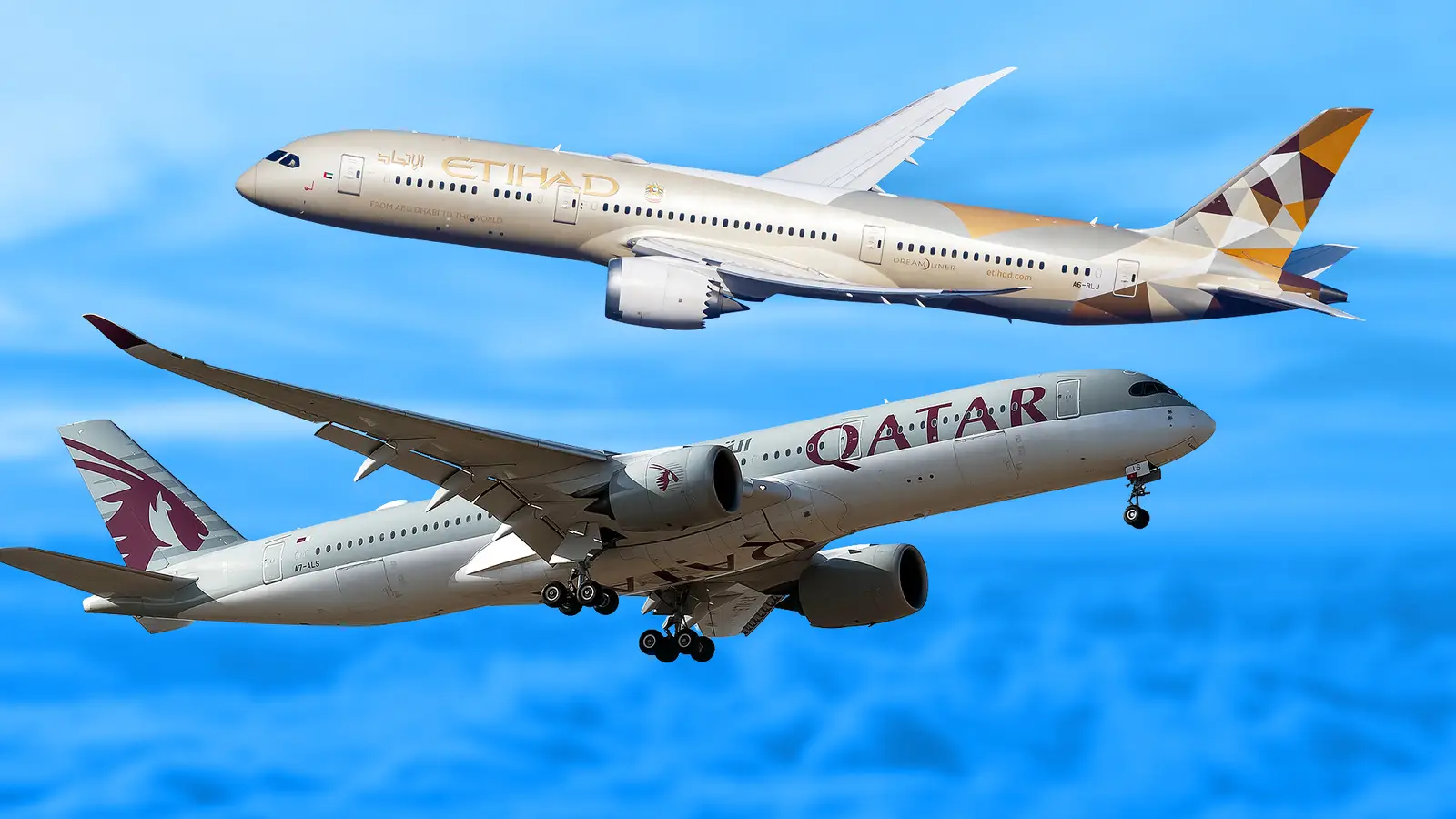Copyright Simple Flying

Aviation is filled with duopolies and triopolies. In the Middle East, it's Emirates, Etihad Airways, and Qatar Airways that dominate the region, and they are known for being super-connectors due to the locations of their hubs. But to make it work, the airlines need scale in both network and total passengers. This means a large fleet of widebody aircraft with high passenger capacity. Emirates' main hub is in Dubai International Airport, while Qatar Airways' hub is at Doha Hamad International Airport. Etihad Airways, the youngest of the three Middle Eastern carriers, is based at Abu Dhabi Zayed International Airport. All three have large fleets primarily made up of widebody airliners, and have built their business models around size. Using data from ch-aviation, which one wins with its fleet? Overview Of The Emirates Fleet Emirates is the oldest of the three largest Middle Eastern carriers, having commenced operations in 1985 after Gulf Air cut back its Dubai operations. Of the three, it has the simplest fleet, made up of only three aircraft families: the Airbus A350, the Airbus A380, and the Boeing 777. Currently, Emirates operates the A350-900, A380-800, 777-200LR, 777-300ER, and 777F, and also has the 777-8, 777-9, 787-8, and 787-10 on order. According to ch-aviation, Emirates has 275 aircraft active. This consists of 10 Airbus A350-900s, 118 Airbus A380s, 10 Boeing 777-200LRs, 119 Boeing 777-300ERs, 11 Boeing 777Fs, one Airbus ACJ319-100, and six Boeing 747-400 freighters. However, the 747s are wet leased from other operators, in which the plane flies with an Emirates flight number but is owned by another company, which also provides crews. Without the 747s, the Emirates fleet is made up of 269 aircraft. Excluding the ACJ319-100 (which is used by Emirates' executive division), this comes out to 268 planes, made up of 257 passenger aircraft and 11 cargo planes. Because all 257 passenger planes are widebodies, this makes the Emirates fleet the largest twin-aisle fleet in the world, and this has contributed to Emirates' meteoric rise as one of the world's largest airlines by passenger count. The Qatar Airways Fleet Qatar Airways commenced operations in 1994, with all flights departing or arriving out of Doha. Whereas Emirates' fleet is made up of three widebody aircraft types, the Qatar Airways fleet is more diverse. For one, Qatar Airways flies 27 Airbus A320-200s, while also owning six Boeing 737 MAX 8s that are set to be removed, and it has taken delivery of two Airbus A321neos. It also has orders for 40 additional A321neos along with 10 A321LRs. But while it does operate narrowbodies, the widebodies are still the backbone of its fleet. Qatar Airways currently operates the Airbus A330 (seven A330-200s and 11 A330-300s), the Airbus A350 (34 A350-900s and 25 A350-1000s), 10 Airbus A380s, the Boeing 777 (seven Boeing 777-200LRs, 57 777-300ERs, and 28 777Fs), and the Boeing 787 (32 787-8s, and 24 787-9s). In total, this brings the Qatar Airways fleet to 270 aircraft. This is currently smaller than the Emirates fleet, but if you exclude Emirates' wet-leased 747s and the ACJ319-100, this makes the Qatar Airways fleet larger by two aircraft. Note, however, that Qatar Airways's freight division is significantly larger than that of Emirates (28 777Fs compared to 11 777Fs and six wet-leased 747s). If one looks at the passenger planes, Qatar's fleet only numbers 242 planes, compared to 257 at Emirates. Where Does Etihad Airways Fit In? Etihad Airways is the youngest of these three carriers, having commenced operations in 2003. Although its base in Abu Dhabi is within driving distance of Dubai, Etihad's fleet composition is similar to that of Qatar Airways. It currently flies 17 Airbus A320-200s, and nine Airbus A321-200s. Additionally, Etihad operates a single Airbus A320neo and six Airbus A321neos that were acquired from Bamboo Airways, alongside two A321LRs with orders for 28 more. Etihad's widebody fleet consists of two wet-leased Airbus A330-200s, eight Airbus A350-1000, eight Airbus A380s, nine Boeing 777-300ERs, six Boeing 777Fs, 38 Boeing 787-9s, and 10 Boeing 787-10s. Its widebody fleet is notably heavy on the Boeing 787 Dreamliner, with far less reliance on the Boeing 777 than Qatar or Emirates. However, its total fleet is also significantly smaller than either, with only 118 active aircraft, 116 excluding the A330s, and 110 excluding the 777Fs. Etihad Airways has always been smaller than its competitors, but its fleet saw significant downsizing in the late 2010s after recording hundreds of millions in losses. It formerly operated a large Airbus A330 and A340 fleet, and Etihad also retired most of its Boeing 777 fleet. Additionally, Etihad has fewer than 100 aircraft on order (28 A321LRs, 12 A350-1000s, 10 A350Fs, 25 777Xs, and 24 787s), as opposed to the huge orders placed by its rivals. Why Emirates Continues To Soar Ahead In May 2025, Emirates announced that it was the world's most profitable airline, beating out US carriers Delta Air Lines and United Airlines. While its fleet is similarly sized to Qatar's, it carries significantly more passengers thanks to its immense Boeing 777-300ER and Airbus A380 fleets. In part, this is why it's so successful, as it's been able to master the art of moving huge volumes of people around the world. Emirates can fill these planes thanks to its massive network, attractive pricing, and the halo effect on its brand from the business and first class cabins on its Airbus A380s. Not only that, but Dubai itself has become a central hub for business and tourism in the Middle East. It's one of the wealthiest cities in the region, and it has a diversified economy that has, in part, been built thanks to the success of Emirates, which has brought increased awareness to the city. This isn't to say that Qatar Airways is worse than Emirates or that Doha isn't a wealthy, economically diverse city. However, Doha is ultimately smaller than Dubai, and Qatar Airways doesn't quite have the same brand recognition as Emirates. Everyone knows Emirates, everyone knows that Emirates is a good airline, and everyone knows about Dubai. This level of success was earned over decades through a commitment to a strong, premium brand, smart business decisions, and a political will to build up Dubai. Why Etihad Airways Has Fallen Behind In the 2010s, Etihad Airways began quickly expanding, and it notably also began purchasing stakes in smaller carriers starting in 2011. Under the name "Etihad Equity Alliance", the carrier purchased minority stakes in Air Berlin, Air Seychelles, Aer Lingus, Virgin Australia, Jet Airways, Swiss carrier Darwin Airline (subsequently rebranded as Etihad Regional), and Alitalia. These decisions proved to be disastrous, as several airlines fell into financial hardship, and the Etihad Equity Alliance was disbanded in 2018. Additionally, Etihad overexpanded as it faced stiff competition from Emirates and Qatar Airways, which were larger with more money. The carrier canceled many of its orders for Airbus A350s and Boeing 777Xs, and today, it's Turkish Airlines that has practically taken its place, since it operates using a similar business model out of Istanbul. Etihad Airways shifted its focus after the COVID-19 pandemic and has gone from being a small super-connector to a large local airline. Etihad now brands itself as a boutique premium carrier, and its turnaround from billions in losses to profitability has been one of the most impressive in modern aviation history. Etihad is planning to double its fleet and triple passenger numbers by 2030, but company leadership has remained adamant that this growth must be profitable and sustainable. Rundown Of The Middle Eastern Three Emirates pioneered the business model of worldwide connections via a Middle Eastern hub while bringing awareness to its home city. Qatar Airways, while not quite on the level of Emirates in terms of scale, is as fierce a competitor as ever. Etihad Airways had to bow out of the fight and downsize to profitability, but now that it's making money again, Etihad is looking to expand again, but in a more profitable fashion.



